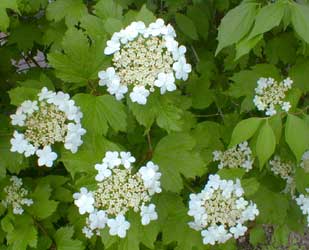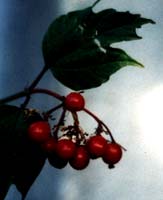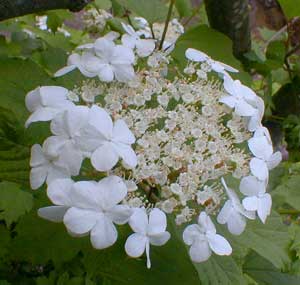
'Wentworth'
American Highbush Cranberry
"Seven days she lurked in brake and field,
Seven nights her course renewed,
Sustained by what her scrip might yield,
Or berries of the wood."
-from "The Russian Fugitive"
by William Wordsworth
by William Wordsworth
Viburnum trilobum is unusually beautiful with its soft maple-like leaves, producing white lacecap flowers mid-May to mid-June, followed by bunches of shiny bright red berries by August, which can be harvested in autumn.
The berries are larger & redder & longer lasting on the Wentworth cultivar; you can see more photos of the fruit on the Wentworth Cranberry Page of the Pomes & Berries Gallery. In autumn, it puts on a wonderful display of pinkish purple leaves (see the 'Wentworth' Cranberry page of the Autumn Leaves Gallery).
 It wants a goodly amount of sun, but in Zone 8 perhaps not quite full sun. Ours gets a fair portion of afternoon sun, but is shaded all morning. It wants moist well draining humousy soil, but is not like Lowbush Cranberry (Vaccinium macrocarpon) which likes swampy conditions, & Highbush Cranberries should never be overwatered. Though somewhat susceptible to black-aphids, it is otherwise nearly impervious to insects or diseases.
It wants a goodly amount of sun, but in Zone 8 perhaps not quite full sun. Ours gets a fair portion of afternoon sun, but is shaded all morning. It wants moist well draining humousy soil, but is not like Lowbush Cranberry (Vaccinium macrocarpon) which likes swampy conditions, & Highbush Cranberries should never be overwatered. Though somewhat susceptible to black-aphids, it is otherwise nearly impervious to insects or diseases.It grows to eight or ten feet high. Our young bush was only titty-high when planted; in one year it was big & bushy at seven feet tall. We planted it at the foot of the back step, & Granny Artemis has built an arbor over the whole back stoop which provides a trellis behind the Wentworth Cranberry, not because the species has any real need to be trellised, but ours needed a wall or barrier or espalier so we can let it get as thick as possible without having to trim it too drastically away from the stoop.
 The berries are not tasty off the bush, being so tart, but make excellent jellies & jams & pancake syrups & sauces. Picked early in autumn they are terribly bitter & may need to be "cut" with sweeter berries to make a good jelly, but they have a lot of natural pectin early in autumn so will not need any pectin added to jell up excellently. Picked after the first or second hard frost, they are softer & not so rich in pectin hence much more palatable. It may sometimes seem like birds simply won't eat them until there is nothing else to choose from, but partly the reason birds wait to eat them late in autumn or in early winter is because that's when they're tastiest.
The berries are not tasty off the bush, being so tart, but make excellent jellies & jams & pancake syrups & sauces. Picked early in autumn they are terribly bitter & may need to be "cut" with sweeter berries to make a good jelly, but they have a lot of natural pectin early in autumn so will not need any pectin added to jell up excellently. Picked after the first or second hard frost, they are softer & not so rich in pectin hence much more palatable. It may sometimes seem like birds simply won't eat them until there is nothing else to choose from, but partly the reason birds wait to eat them late in autumn or in early winter is because that's when they're tastiest.There is a small specialized market for American Highbush Cranberry jams, sauces, & pancake syrup, & V. trilobum is almost always the species grown or harvested commercially for Canadian-made gourmet specialty jellies & syrups. V. edule, the Alaska Highbush Cranberry (or Squashberry), also has some commercial use in Native American small businesses, notably the Seldovia Village Tribe which manufacturers & sells Chesloknu brand highbush cranberry jelly, in addition to both red & yellow salmonberry jelly, Alaskan blueberry jelly & jam, Highbush Cranberry Jelly. The Wilp Sa Maa'y Harvesting Cooperative of Northern British Columbia is another source of highbush cranberry & huckleberry jellies as well as soapberry preserves, harvested usually in the Kispiox Forest then processed into jellies or preserves by three cooperating First Nations then sold through the Cooperative.
The cranberry jelly from Alaska Wilderness Gourmet, Inc., contains a lot of added fructose sugar & does entirely overcome any tendency to bitterness for V. edule, though the species has a medicinal aftertaste which is a pine-tarry. The same company makes jellies & syrups from native fireweed blossoms, from rosehips, from spruce tips & wild blueberries, mainly harvested from the Tanana River wilderness, & in regions from Ketchican to Nome. My favorite of their products is Alaska Birch Syrup, which takes five gallons of sap to make one bottle of syrup, & has a subtle but complex flavor like no other syrup I've ever tasted.
Hybrids developed in Sweden & Russia for crop-use may well include V. opulus in their heritage though mainly even in Europe they are working with the American Highbush Cranberry instead of their native V. opulus because the European species stands at the high end of tartness.
V. opulus or European Highbush Cranberry was a traditional food in medieval & ancient Scandinavia, but is in the modern world considered too tart to be edible, & so displaced by the American Highbush as an orchard shrub for fruit crops. Even so, the more daring can make spiced jelly even out of V. opulus, cutting it with sweeter berries, further sweetened with apple or grape juice, & dressed up with cranberry spices, a method that makes even berries of hawthorn, manzanita, or cotoneaster comestible.
For a garden's autumn or pre-winter harvest, if no single bush produces a basketfull, or if most of the berries are left behind for decorative value in the garden, a sampling of all these sorts of tart berries can be mixed together to add up to enough for canning purposes.
A mix of tart berries will make a unique spicy jelly akin to commercial cranberry sauce, which would be more rewarding than making six kinds of spicy jelly which would only be liked by whoever likes cranberry sauce in the first place. But of the tart autumn/winter berries that might be harvested, V. trilobum & V. edule are considered the most edible of all Highbush Cranberries, & when picked after a couple of chilling morning frosts are decreasingly tart. To beat birds to them (the birds, too, often wait until after frost sweetens them up a bit) they can be picked ahead of the frost, then kept a couple of days in the freezer. If picked underripe they will not need pectin added to set up as jelly, but will need a higher amount of sugar added. Regular recipes for lowbush cranberry jelly or sauce are easily adaptable to highbush.